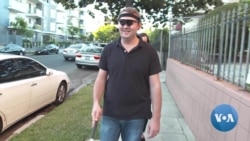A groundbreaking new device is helping those who are blind see in a new way by helping them perceive the world around them.
Jason Esterhuizen never thought he'd be able to see light or movement again after a car accident left him blind. But with the flick of a switch, his world suddenly grew brighter.
“I still can't put it into words. I mean from being able to see absolutely nothing, it's pitch black, to all of a sudden seeing little flickers of light move around,” Esterhuizen said.
While it's not normal sight, Esterhuizen can navigate the world around him. Dr. Nader Pouratian is one of the researchers at the UCLA Medical Center.
“Being able to tell where a doorway is, being able to tell where the sidewalk begins or ends or where the crosswalk is, are all extremely meaningful events that can help regain or help these people regain some form of independence,” Pouratian said.
Here's how it works: a small generator is implanted into the brain. The other parts consist of a video camera on a pair of sunglasses and a processing unit that can fit in a pocket. When the user points the camera in a particular direction, a signal is sent to the processing unit and then back to the glasses, which communicate wirelessly with the implanted generator. This stimulates a pattern onto the visual cortex of the brain and allows users to detect movement and patterns of light. And it all happens in a matter of seconds. Pouratian says this technology is a first.
“We basically have the video camera and the video processing unit functioning or performing the functions of what the eye normally does,” Pouration said.
Esterhuizen is one of two people in the U.S. testing this technology.
“There's little white dots on a black background. It's like looking up at the stars at night,” Esterhuizen said.
The technology — called Orion — is manufactured by a company called Second Sight. It's being tested at the UCLA Medical Center and the Baylor College of Medicine.
As he learns what each flicker of light represents, Esterhuizen is helping this technology become more useful.
“It's someone moving across the room, walking past me or walking away from me, or it's a light against the wall. It was just amazing to have some form of functional vision again,” Esterhuizen said.
Esterhuizen can now do everyday activities he once could not.
"Crossing the road is much easier and much safer for me because I can look down and just follow the white line that's painted on the road,” Esterhuizen said.
The researchers believe that one day this technology could help people who have lost their vision due to illnesses like glaucoma or diabetes as well as those with low vision or who were born blind.






